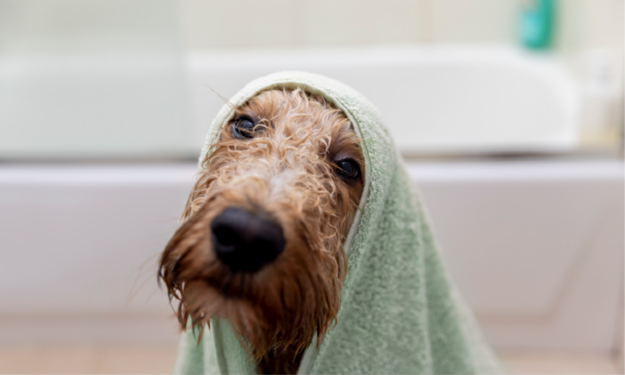How Often Should You Bathe Your Dog?

Most dog owners know that their dog will eventually become pretty smelly if they are not bathed, but they aren’t exactly sure how often they need a bath. The answer depends on many factors, including breed, coat type, coat length, activity level, and their skin condition.
Here are the top considerations to help you decide how often to bathe your dog, and when to call in expert help.
Why is bathing and grooming important?
The skin is your dog’s largest organ and serves to protect their bodies from the outside world. Keeping the skin and coat clean and free from matting ensures this barrier remains intact and strong. Your dog’s skin is also home to a population of bacteria and fungi—their microbiome— that live together in harmony and protect your dog’s overall health. Dirty or damaged skin can upset this balance and lead to infections and compromised immune function. If your dog’s skin is already compromised by allergies or other medical skin conditions, bathing and grooming are key treatment aspects.
Brushing is also an important aspect of overall grooming. Regular brushing removes dead hair, skin cells, and dirt, distributes natural oils to hydrate the fur. It also prevents long hair coats from matting, which can lead to skin ulcerations and bruising.
How often should I bathe my dog?
How often you bathe your dog depends on their individual skin and coat characteristics. Most healthy dogs need a bath every one to three months to minimize odor and oil buildup, but this can vary depending on the following factors:
- Breed — Dogs with oily coats (i.e. Retrievers) may need a bath every few weeks to reduce odor, and will benefit from daily brushing to remove hair and distribute oils. Some hound breeds, Bulldogs, and Pugs also develop odor faster.
- Coat type — This is probably the most important factor in determining how often to bathe. Thick, double-coats (Siberian Huskies, Chow Chows) shed constantly, which means bathing is required less often—every two or three months—but daily brushing is important. Short, single, or wiry coats (Pitbulls, Weimaraners, terriers) are also relatively low maintenance—a handful of baths per year is sufficient. Soft, curly coats and non-shedding coats (Poodles, Bichons, Shih Tzus, Yorkshire Terriers) collect dirt faster, so bathing monthly is ideal.
- Activity level — Dogs who spend time outside need a good brushing and bath each time they become visibly dirty, which could be once a week or more. Active dogs also tend to develop odor faster.
- Skin conditions — Allergies, skin infections, and excessively oily or dry skin increase bathing needs. Most of these dogs need baths one to three times per week, depending on veterinarian recommendations.
When in doubt, use your dog’s smell as a guide. While we’re all familiar with the typical “doggy” odor, your dog’s smell should be faint and barely noticeable. If the odor is noticeably strong or transfers onto blankets and bedding, your dog probably needs a bath.
Is it possible to bathe my dog too much?
Yes, you can bathe your dog too much. If your dog has healthy, normal skin, excessive bathing—more than once per week—can dry out their skin and coat and compromise the skin’s moisture barrier. Remove as much dirt as possible with brushing to prolong the time between baths. But, bathing your dog several times per week is okay if your veterinarian recommends medicated baths as part of a skin condition treatment plan.
How do I choose the right shampoo for my dog?
Dogs’ skin has a different pH than humans, so they need shampoos designed specifically for dogs. Most dog shampoos do not contain harsh cleansers like sulfates that would completely strip their natural oils. Choose a soothing, moisturizing oatmeal or aloe formula for dogs with normal to dry skin. Dogs with excessive oil or skin conditions may require a veterinarian-prescribed medicated shampoo.
Dogs with long or fluffy coats often need a dog-specific conditioner following their shampoo to help keep the hair coat moisturized and tangle-free after the dirt and oil are removed. Short hair coats can air-dry after bathing, but longer or dense coats should be blow dried after conditioning and rinsing to prevent trapping moisture on the skin.
When should I take my dog to the groomer?
Sometimes, bathing is best left to the professionals. You may choose to consult a groomer rather than undertake the task yourself for these reasons:
- You need professional recommendations or help determining your dog’s coat type and grooming needs.
- Your dog is large or unruly.
- Your dog has an extremely thick or heavily shedding coat.
- Your dog has ear, leg, or rear end “feathers” that need trimming.
- Your dog has a continuously growing, non-shedding coat that needs regular full-body cuts.
- You don’t have the time, energy, or space to bathe your dog at home.
- You’d like all your dogs grooming tasks completed by a professional, including bathing, brushing, trimming, ear cleaning, and nail trimming.
Bathing your dog regularly not only keeps them fresh and clean, but also ensures they remain comfortable and healthy. Choosing grooming products and determining your dog’s grooming needs can be confusing, so contact a local professional groomer or ask your veterinarian to recommend what is best for your dog.